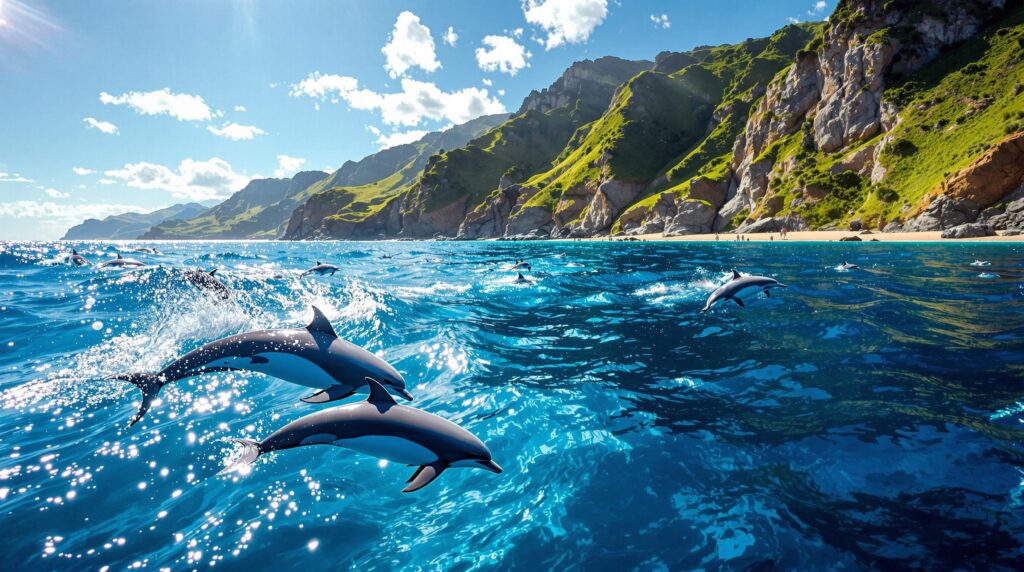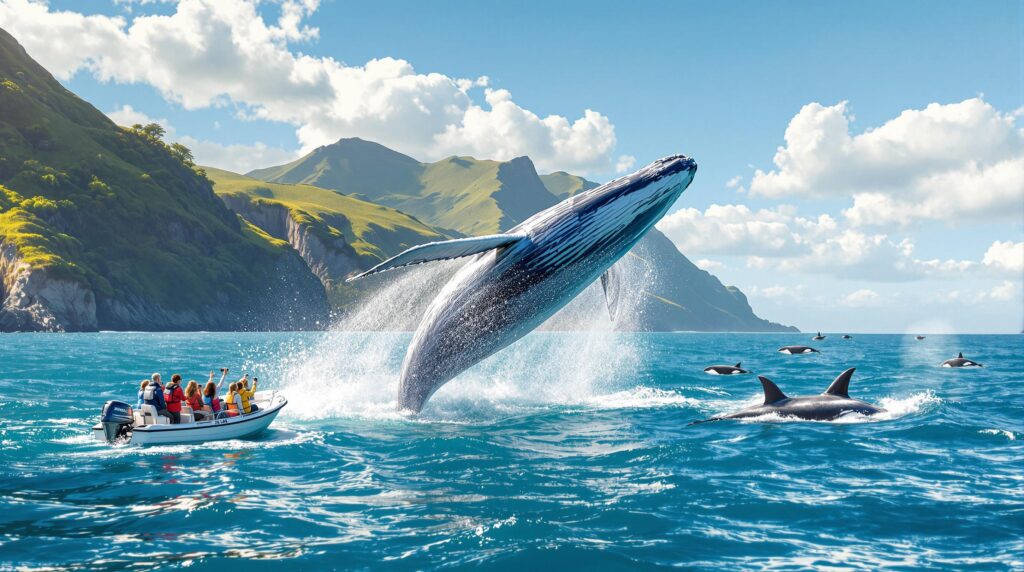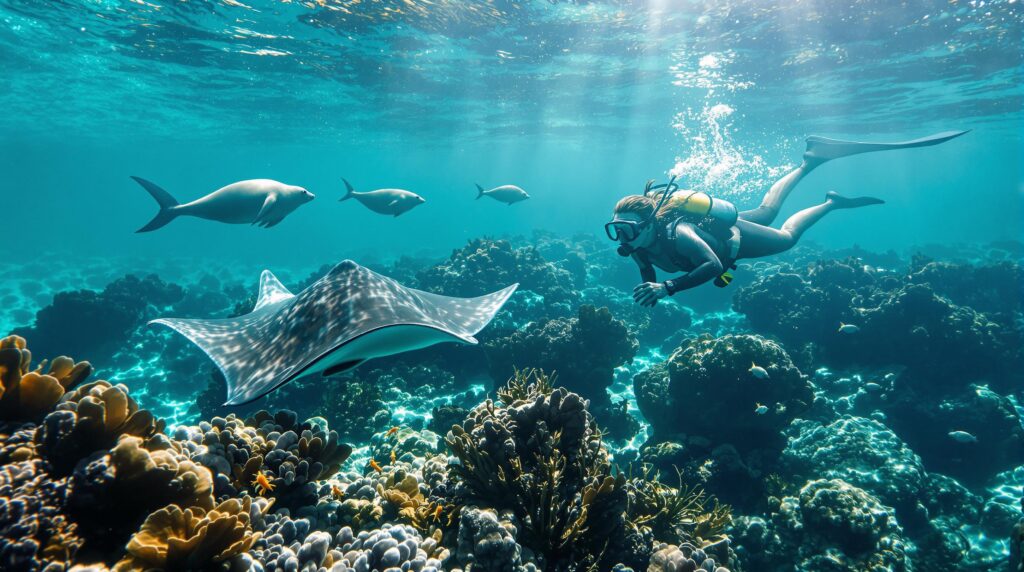I’ve spent countless days exploring the serene coastal waters of New Zealand, where dolphins frolic in the gentle surf and beneath the deep blue horizon. My journey has led me to witness an extraordinary variety of these sleek marine mammals—from the rare Hector’s Dolphin Adventure to the playful antics of Common Dolphin Watching pods. Every moment immersed in these encounters has enriched my passion for the ocean and the natural beauty of this remarkable country.
The charm of New Zealand resides in its diverse marine life, colorful coastal towns, and the heartwarming welcome bestowed on visitors. As I recount my personal experiences, I am reminded of the crisp ocean air, the calls of native seabirds, and the excitement of spotting a pod at just the right moment. The following reflections highlight the best places to appreciate dolphin life, share practical tips on organizing a marine tour, and offer insights on savoring nature responsibly while connecting with the local culture.
Exploring New Zealand dolphin diversity
New Zealand’s coastal waters host a dazzling assortment of dolphin species that capture the hearts of travelers and locals alike. I’ve observed up to 13 species in these vibrant marine habitats. Oftentimes, these waters surprise even the most experienced wildlife enthusiasts when a group of dolphins appears unexpectedly near the shore. Among these fascinating creatures, the tiny and endangered Hector’s dolphins steal the show. Known for their distinctive black and white markings, these dolphins are a symbol of New Zealand’s unique natural heritage and a delight for Marine Discovery Centre visitors.
The calm, protected waters provide ideal conditions for a variety of dolphins, including the common, bottlenose, and dusky dolphins. As I sailed along the coastline, it was impossible not to admire the grace of these animals as they danced on the crests of gentle waves. I discovered that some species, such as orcas and pilot whales, are sometimes mistaken for dolphins due to their similar appearances, yet their behaviors and sizes reveal a different world of ocean life.
During many voyages, I joined local Dolphin Explorer and NZ Dolphin Safaris tours that emphasize low-impact wildlife observation. I experienced moments where the sea and sky merged in perfect harmony, offering an intimate glimpse into nature’s wonders. Whether you are a seasoned traveler or a new visitor, these marine encounters are a reminder of the fragile beauty that surrounds us.
It is essential to appreciate and protect these creatures, as many face threats from human activities and environmental changes. I always encourage fellow travelers to consider eco-friendly practices and to remain mindful when enjoying these natural spectacles. For more detailed insights on dolphin habits and conservation efforts, you might visit New Zealand Dolphins and check out further reading on local dolphin conservation projects.
Below is a list of some of the fantastic dolphin species you can see in New Zealand’s waters:
- ⭐ Dusky Dolphin Experiences – Enjoy their acrobatic leaps in the cool sea.
- ⭐ Common Dolphin Watching – Spot large pods engaging with the surf.
- ⭐ Hector’s Dolphin Adventure – A truly rare encounter with the smallest dolphins in the world.
- ⭐ Bottlenose Dolphins – Often seen riding boat wakes on serene days.
- ⭐ Orcas & Pilot Whales – Sometimes mistaken for playful dolphins.
In my detailed records of wildlife cruises, the significance of knowing where and when to go became clear. The best moments arose from combining a passion for travel with the precision of timing and location. I have often marveled at how the ocean’s rhythms dictate movement, prompting spontaneous bursts of energy among these mammals. A treasured memory includes a quiet afternoon when I was floating alongside a pod of dusky dolphins, their sleek silhouettes illuminated by dappled sunlight.
A table below summarizes some of the prime locations and conditions that helped me secure unforgettable dolphin encounters:
| 🌟 Location | 🌟 Species Observed | 🌟 Best Time |
|---|---|---|
| Bay of Islands | Bottlenose, Common, Orcas | Warm months |
| Hauraki Gulf | Common, Bottlenose, Orcas | Late fall to winter |
| Banks Peninsula | Hector’s Dolphin | Year-round, with peaks in winter |
The variety of species and regions ensures that every dolphin enthusiast will find a unique experience tailored to their passion. Programs like Oceanic Dolphin Tours prioritize sustainable practices and create immersive adventures with local experts who know the intricate details of each habitat. I must highlight the importance of choosing ethical tour operators who balance the thrill of discovery with the responsibility of conservation.
Discover more about these tours on resources like Best Places to See Dolphins and learn the nuances of these marine adventures on Wildlife Tours NZ. As I prepared for my next adventure, every new encounter deepened my commitment to preserving these fragile ecosystems. A truly memorable excursion is one that leaves an indelible mark, a connection that is both inspiring yet humbling.
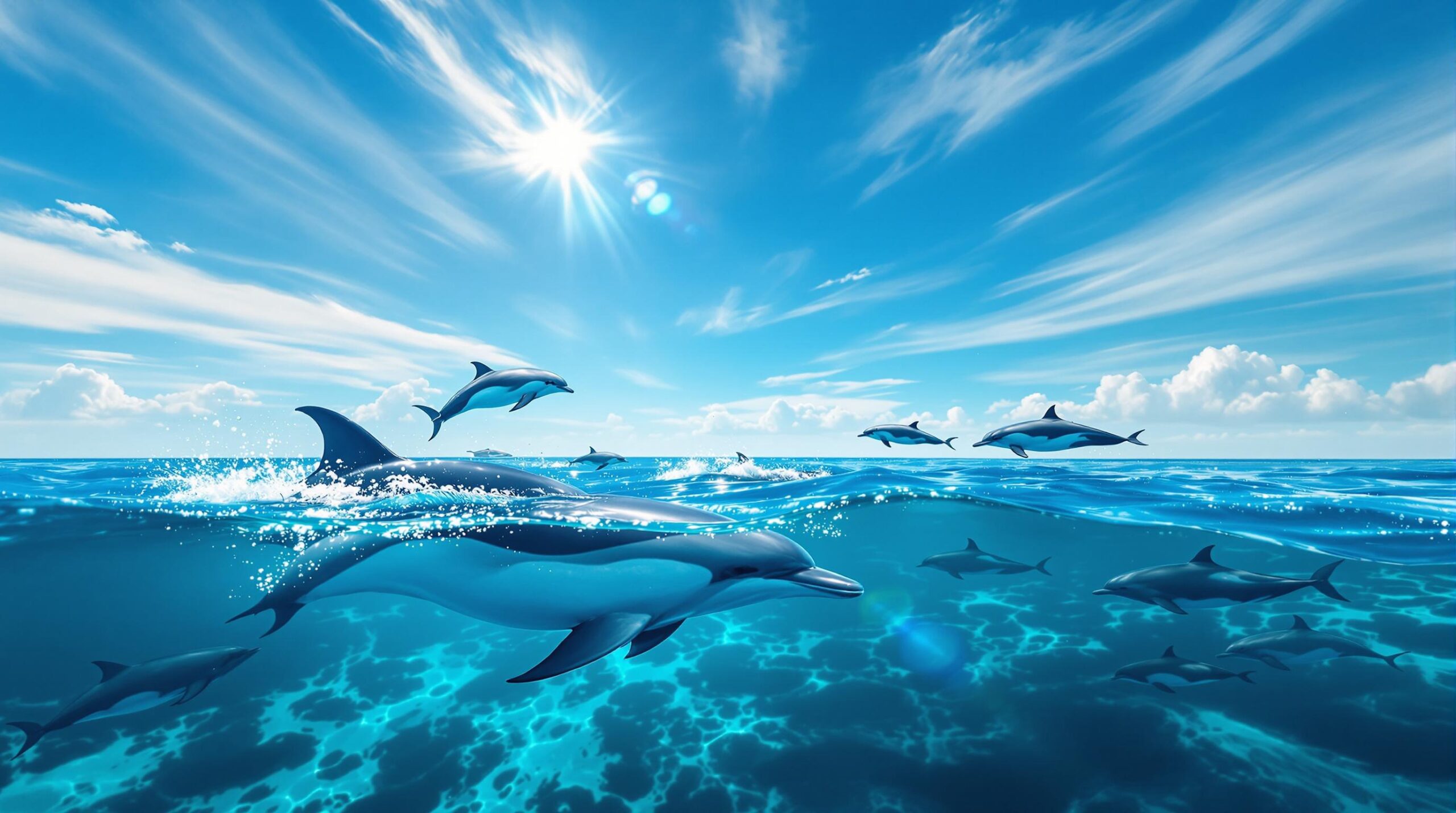
Diverse species and their habitats
My personal journey through the varied marine environments of New Zealand has constantly amazed me. I have experienced firsthand the magical interplay between sea, sky, and dolphin life. The habitats that support these ecosystems range from sheltered bays to expansive open waters. In each setting, the behavior and distribution of these creatures reveal fascinating insights about their adaptation and survival.
The intricacy of these ecosystems results from a delicate balance between natural conditions and the constant cycles of migration and breeding. For example, the rare Hector’s dolphins found near Banks Peninsula thrive due to the calm, temperate waters that seem to nurture their every move. How these dolphins interact with their environment continues to be a captivating subject for researchers and passionate explorers like myself. On some days, I felt like I was part of an enchanting dance, where every splash and every leap told a story of nature’s resilience.
Joining a local operator like Wildlife Tours NZ allowed me to understand the behavior and ecological challenges that these dolphins face. When setting out on a small boat to follow a pod, the experienced guides connect every sighting with crucial conservation messages. They emphasize that witnessing these moments is also a responsibility. One must be aware and respectful of the natural spaces, ensuring that future generations have the opportunity to marvel at these spectacles as well.
One delightful memory includes a sunlit morning near the Bay of Islands when a group of common dolphins appeared to greet me from the water. The sheer energy of their synchronized movements created a playful show just for the lucky few on board. I was reminded of how interconnected life is, reminding me to always treasure every bit of wildlife experience. Additional insights on similar encounters can be found via New Zealand dolphin tours that often include detailed itineraries and expert commentary.
While some might focus on the thrill of the sighting, the underlying science behind dolphin behavior is equally intriguing. Research continues on how environmental changes, human activity, and natural cycles impact the populations. Peer-reviewed work discussed on platforms like scientific marine studies confirm the need for sustainable tourism practices. On board the vessel, I would often share these insights with fellow travelers, connecting facts with my own impressions and dreams.
Every expedition reaffirms the importance of sustaining the ocean’s health. The cumulative experiences from rides, dives, and quiet observation out at sea resonate deeply with me. I always felt a growing connection with the environment, realizing that every ripple in the water was a piece of a larger narrative—one that invites us all to be mindful stewards of nature. Detailed programs provided by tour companies like New Zealand Dolphin Tours also offer practical guidance on how to enjoy these experiences responsibly.
Nevertheless, the experience is even richer when one learns about the interdependent life cycles of marine wildlife. I recall listening intently during a briefing by a marine expert while cruising through the Hauraki Gulf. His insights into the migration patterns, breeding cycles, and even the social structures of these creatures brought an extra layer of depth to the adventure. I encourage readers to explore more on fascinating topics via resources like dolphin information pages, where facts blend with inspiring images and stories.
Embracing the tranquility of the sea and the wonder of such exotic dwellers is an experience that beckons many. Every splash reminds me of nature’s fragile poetry—an invitation to join a movement that cherishes marine life and celebrates the spirit of adventure. Whether you join a Oceanic Dolphin Tours outing or embark on a personal voyage, the magic of New Zealand’s dolphin-rich waters will leave you with memories to treasure.
Best locations for dolphin encounters
My wanderings along New Zealand’s extensive coastline continuously lead me to breathtaking spots where dolphins grace the horizon. It feels as if every coastal region presents a distinct experience, each with its signature species and moments of wonder. The Bay of Islands, Hauraki Gulf, Banks Peninsula, and Kaikoura each offer unique settings that captivate every nature lover. One can spend days chasing the magical interplay of light and water where pods perform their aerial ballets, creating mesmerizing scenes that seem almost otherworldly.
The Bay of Islands stands out as a gem for those who seek an intimate marine encounter. With its protected waters and reliable dolphin sightings, it’s easy to see why it is a favorite among Dolphin Encounters enthusiasts. I recall joining a well-reviewed cruise that navigated narrow channels and revealed secret coves hosting an array of marine life: sparkling groups of bottlenose dolphins and occasionally a majestic orca gliding gracefully by. The guides, well versed in local marine lore, enriched the experience with details about each species’ habits. More insights into this fantastic region are available on top dolphin-spotting tips.
After several trips, I discovered another favorite: Hauraki Gulf. This expansive marine playground off Auckland’s coast offers more than just dolphins. In addition to the familiar presence of common and bottlenose dolphins, the gulf plays host to transient whales and seabirds, creating an immersive tableau of marine life. There is a special thrill in gliding near the open ocean and witnessing nature in a lively performance. Local operators furnish additional layers of storytelling, intertwining maritime history with current observations. It is recommended to check out additional voyage ideas on platforms such as dolphin boat tours.
The journey extends to Tauranga in the Bay of Plenty, where a busy harbor merges with the wild open ocean. I once took an excursion that departed from Tauranga, spending hours on the water, observing not only dolphins but also humpback whales during the migration season, playful pilot whales, and even blue penguins along rocky shores. These all contribute to an adventurous maritime narrative that every visitor cherishes. Detailed itineraries are often shared by local guides who regularly collaborate with organizations such as NZ Dolphin Safaris and Dolphin Explorer to ensure an authentic and tasteful experience.
For travelers who wish to immerse themselves in nature yet have a taste for comfort, the Marina Discovery Centre and other local hubs stand ready to offer practical advice and valuable local insights. I have found that engaging with these experts transforms a simple boat ride into a deeper exploration of marine ecosystems. Tours like those offered by Wildlife Tours NZ provide not only visual delight but also a wealth of educational content, enhancing every voyage with layers of meaning and respect for the ocean’s subtle rhythms.
Embedded in the tapestry of the coastline, smaller towns like Kaikoura and Otago Peninsula also add to the diverse selection of dolphin encounters. In Kaikoura, nestled between rugged mountains and the open sea, the constant interplay of warm and cold currents creates a magnet for marine life. I have marveled at the sight of dusky dolphins, whose dark silhouettes contrast strikingly with the frothy crests of waves. The region’s magnetic charm extends beyond dolphins—whale-watching and even seal spotting round out the experience, encouraging guests to keep their cameras ready. To add context and share personal experiences from this area, you might explore stories on local dolphin blogs.
Below is an engaging list of prime spots and highlights for dolphin appearance in New Zealand:
- 🌟 Bay of Islands: Immaculate waters home to bottlenose and common dolphins.
- 🌟 Hauraki Gulf: Vast marine space where dolphins and whales mingle.
- 🌟 Kaikoura: A scenic blend of mountain majesty and ocean life, featuring dusky dolphins.
- 🌟 Banks Peninsula: A sanctuary for the rare Hector’s Dolphin Adventure.
- 🌟 Otago Peninsula: A hidden gem where both wildlife and history intertwine.
Local travel companies like Oceanic Dolphin Tours and New Zealand Dolphin Tours lend an authentic perspective to every excursion, often sharing behind-the-scenes insights into the vibrant coastal communities that support these adventures. Their curated itineraries ensure that every traveler, whether a seasoned explorer or new to marine wildlife, is treated to an unforgettable journey. For more detailed travel routes and recommendations, check out sources such as comprehensive wildlife guides and explore travel advice on New Zealand travel sites.
This vibrant scene of marine activity is not only a treat for nature enthusiasts but a stimulating learning environment that nurtures a deeper appreciation for aquatic conservation. Every sighting, every shared smile during a tour reinforces the connection between humanity and nature. My repeated journeys have taught me the value of serene moments at sea—a reminder that every ripple holds a story waiting to be heard.
The friendly culture, the layered history of the coast, and the wide-open canvas of the blue ocean continue to call out to all who are willing to explore. Encounters with dolphins offer not just a spectacle, but a personal awakening to the wonders of the natural world. Whether choosing a guided expedition or setting out on a self-led adventure, staying informed and respectful adds immeasurable value to every trip.
Marine tours and wildlife experiences
My experiences with organized marine tours have deeply underscored the importance of connecting with expert guides who truly understand New Zealand’s rich marine biodiversity. Collaborations with renowned operators such as Dolphin Explorer, NZ Dolphin Safaris, and Marine Discovery Centre have provided me with insights that go far beyond mere sighting opportunities. Each excursion was not just a ride on the waves, but a carefully curated educational experience that revealed the hidden stories of the ocean.
On a memorable day in the Hauraki Gulf, I embarked on a journey led by local experts whose passion for marine life resonated through every narrative. They spoke of the subtle differences between common and bottlenose dolphins, and the special conditions that attract the rare Hector’s dolphins to Banks Peninsula. During these trips, I was blessed with the chance to witness firsthand how these experts balance the thrill of discovery with the utmost care for the ocean’s delicate balance. Every comment they made heightened my appreciation for the species and their environment.
These tours provide an array of experiences—if you fancy a relaxed cruise with panoramic views or a more adventurous sea kayaking trip, there is something to match every traveler’s preference. Often, a quiet moment on a small vessel becomes a window into an unspoken narrative between nature and humankind. Detailed itineraries, interactive sessions on marine conservation, and practical tips for respectful wildlife viewing are embedded within every program. Engaging with these tours reinforces my belief that responsible tourism is the best way to preserve our natural heritage.
The thrill of spotting a playful pod amid azure waters is amplified by the knowledgeable commentary provided during the tours. The technical aspects of each species’ behavior are interwoven with anecdotes that bring a personal touch to the experience. An enlightening part of one tour was learning about the impact of seasonal changes on dolphin migration patterns. One guide explained how the migration of humpback whales and transient visits of orcas create unique opportunities for capturing unforgettable moments, all while aerating a broader understanding of local ecology.
These hands-on experiences resonate with my own passion for nature and sustainability. As we glide through calm waters and share smiles with fellow enthusiasts, the excitement is palpable. Every sound, every ripple, enhances the memory of these encounters. I was often reminded that while the ocean spans thousands of miles, the moments of connection remain deeply personal—each journey a testament to nature’s delicate artistry.
Here is a detailed list that outlines some of the benefits of taking organized marine tours:
- 🌟 Expert guidance that enriches your knowledge of marine life.
- 🌟 Tailored experiences that range from gentle cruises to adventurous kayaking.
- 🌟 Opportunities to see multiple species, including rare encounters like Hector’s Dolphin Adventure.
- 🌟 Sustainable practices that ensure minimal impact on the ocean environment.
- 🌟 Memorable narratives and personal stories shared by experienced guides.
Every tour fosters a greater awareness of marine conservation and nurtures lasting memories. I have always been impressed by the meticulous planning and unwavering dedication of tour organizers. They blend local wisdom with modern conservation practices, treating every journey as a chance to share the wonders of New Zealand’s coastal treasures. More details on similar tours are available via resources like wildlife exploration guides and marine environmental reviews.
Sharing a cup of coffee with guides after a day on the water, I often revisited the stories told throughout the journey. These moments reveal how deeply the culture of respect for nature is woven into the fabric of life in New Zealand. My spirit was lifted by each shared story—a blend of adventure, humor, and healthy respect for nature’s wonders.
For anyone seeking to dive deeper into these adventures, I highly recommend scheduling a session with one of the local marine experts. Their insights enrich your experience, ensuring you grasp the nuances of every ripple and splash. The thorough planning and friendly interaction remind me why I keep returning to these magical waters. Every excursion becomes a precious chapter in my lifelong diary of travel, offering both inspiration and practical advice for future journeys.
Immersive dolphin experiences through local adventures
The call of the ocean and the allure of dolphin encounters have a way of drawing adventurers into New Zealand’s rugged coastlines. My heart has led me to experience the thrill of dolphin spotting not only from boats, but also by venturing into the waters through sea kayaking, paddle boarding, and sometimes even snorkeling. Each method of exploration offers its own unique narrative and personal engagement with nature. Venturing out on a kayak, for example, brings you face-to-face with the rhythmic pulse of the ocean, where the quiet sound of paddles and the distant calls of seagulls create a symphony that soothes the soul.
Local experts emphasize that connecting directly with the water fosters a deeper understanding of the marine ecosystem. When I embarked on a kayaking tour near the Otago Peninsula, I was enveloped in the raw, untamed beauty of the coastal environment. The experience was intimate—an unguarded moment where I truly felt part of the natural world. Gliding silently over calm waters, I noticed a pod of bottlenose dolphins playing nearby. Their curious eyes and graceful movements painted a serene picture that I will cherish forever. Such moments remind me that every encounter is part of a grand tapestry of life’s continuous flow.
For adventure lovers who treasure a hands-on approach, local operators such as those featured on scenic coastal drives and whale watching expeditions offer exciting opportunities to blend cultural insights with wildlife observation. I have always found that a day spent on a kayak or a small boat not only exposes you to the majesty of dolphin encounters but also to the rich narratives of the region’s history and local life. The tour guides, passionate about every ripple in the sea, weave stories of how these creatures have been part of the local folklore for centuries.
A particular highlight was a combined dolphin and seal watching tour around Akaroa. There, I witnessed the harmonious blend of playful dolphins and inquisitive sea lions. The tour provided ample time to explore the area, learn about local legends, and even enjoy a scenic drive along picturesque routes. Engaging with these stories made the entire journey more enriching. The local enterprise, promoted on sites like French Charm Excursions and scenic day trips, has built a reputation for delivering immersive wildlife experiences that combine adventure with cultural storytelling.
Alongside the thrill, practical concerns such as safety, comfort, and environmental responsibility remain a priority during these adventures. Before setting off, I always ensure that the tour operators provide comprehensive briefings that emphasize respectful behavior around wildlife. These guidelines are crucial for preserving the delicate balance of the marine ecosystem. Detailed advice, such as maintaining a safe distance and using eco-friendly equipment, enriches the journey while ensuring that the impact on nature is minimal.
Inclusively, this approach weaves together local heritage and modern conservation practices. The tours I participated in were marked by their authentic representation of coastal life, inclusive of local legends and practical insights. Their narratives often featured personal accounts of previous excursions—stories that connect the dots between past traditions and modern sustainable tourism. One unforgettable instance was when a guide explained how local communities have safeguarded these dolphin populations for generations, blending tradition with a forward-thinking approach. Such moments add layers to our understanding and create lasting impressions.
For those looking to plan a similar excursion, here is a list of activities that I found especially noteworthy:
- 🌟 Dolphin Encounters via intimate sea kayaking tours.
- 🌟 Guided paddle boarding sessions paired with marine observation.
- 🌟 Scenic boat cruises that merge coastal drives with wildlife sightings.
- 🌟 Local cultural engagements that share regional history and traditions.
- 🌟 Options for combining dolphin watching with seal and bird spotting.
The spirit of adventure is heightened when you mix physical engagement with insider local knowledge. Every paddle stroke becomes a dialogue with nature, inviting you to conquer personal boundaries while being immersed in the beauty of New Zealand’s marine landscapes. Connecting with local tour operators like NZ Dolphin Safaris and Oceanic Dolphin Tours ensured my experiences were both memorable and enriching. Their passion, combined with detailed guidance, transformed each outing into an intimate celebration of marine life.
A distinctive aspect of these adventures is the emphasis on sustainable tourism. Operators often discuss strategies to reduce our carbon footprint and to monitor the human impact on fragile ecosystems. Their commitment to preserving nature confirms that every journey is as much about education as it is about experience. Sharing these moments with kindred spirits amplifies the joy of discovery—a feeling that resonates long after you leave the water behind.
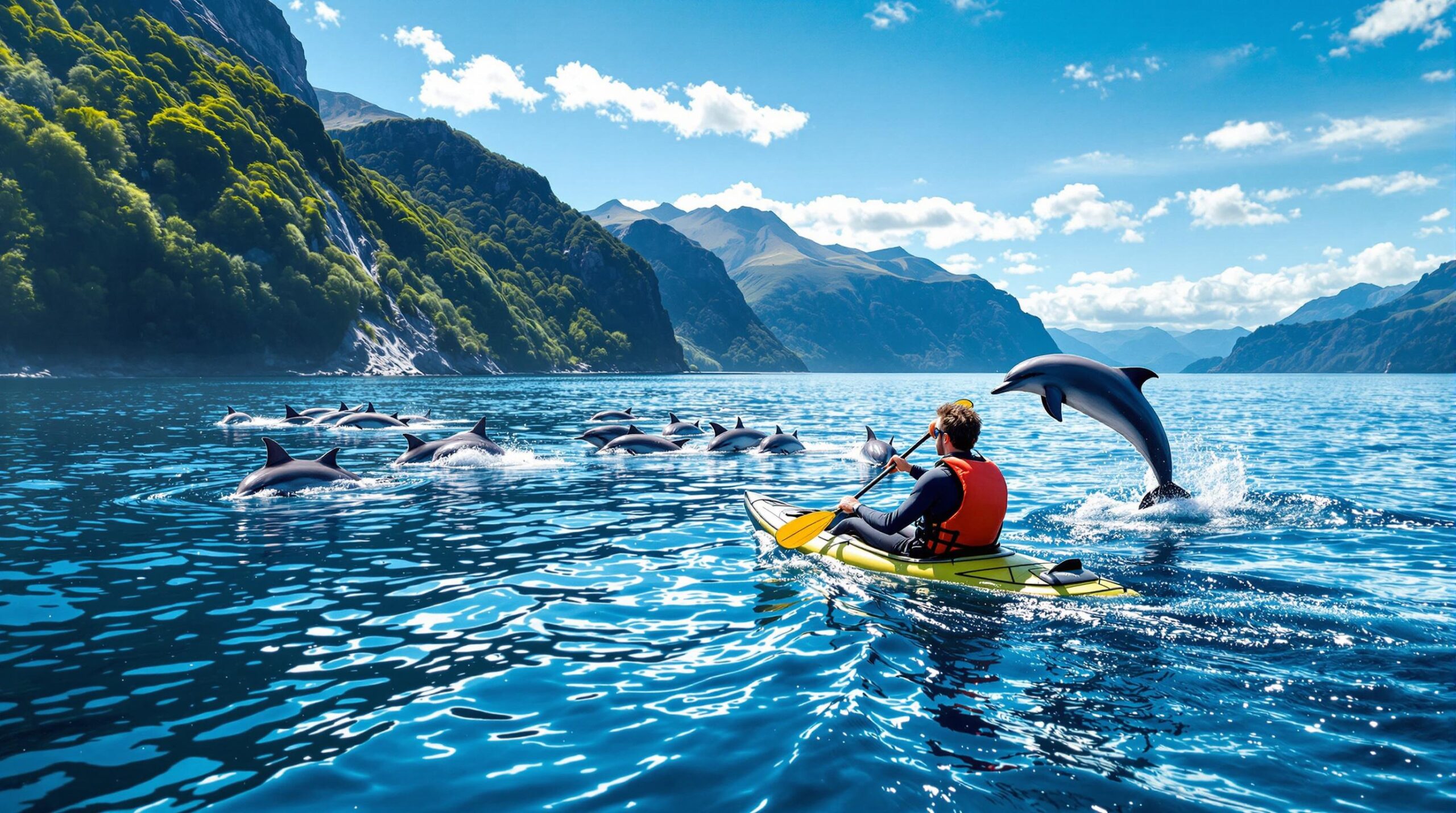
Every paddle, every quiet moment when the sea mimics the sky, and every delighted laugh as a dolphin surfaces reminds me why I love being out there. The memories of these local adventures continue to inspire my travel narratives and encourage others to delve into New Zealand’s rich tapestry of coastal life.
On the water: kayaking, cruises and more
Being on the water is an immersive experience that engages every one of your senses. From the gentle splash of the waves to the sight of dolphins leaping in synchrony, each moment is a vivid reminder of nature’s wonders. I spent hours gliding through pristine waters, sometimes in a kayak where the silence enabled me to fully absorb every detail around me. The thrill of a dolphin appearing out of nowhere while I paddled was akin to a personal invitation from the sea.
Every activity—from traditional boat cruises to intimate kayaking tours—offers its own array of insights into New Zealand’s dynamic coastal environment. I have often been amazed at how the environment changes from one location to another. For instance, cruising around the sheltered bays near Otago Peninsula exposes you to gentle, undulating waves that seem almost choreographed. These peaceful waters, coupled with the playful antics of spotted dolphins, create an ambiance that is both serene and exhilarating.
The tours I joined consistently emphasized sustainable practices. As a participant in several local adventures, I observed firsthand how guidelines such as maintaining safe distances and limiting engine use preserved the natural behavior of the marine species we encountered. I learned valuable lessons in marine ethics that I now share with fellow travelers. This responsible tourism supports operators like those behind Dolphin Encounters and Dusky Dolphin Experiences, ensuring that these natural spectacles remain unspoiled for future generations.
While the thrills of the open ocean are undeniably enticing, the experience is deepened by cultural stories. I recall listening to captivating local anecdotes about how communities have coexisted with these playful creatures for decades. One anecdote described how the dolphins were seen as symbols of luck and guardians of the sea, a perspective that lends a spiritual dimension to every sighting. Such stories instilled in me a deeper respect for the local culture and the interconnectedness of life.
For those planning their own adventures, here is a table that summarizes some practical tips and expected experiences during a dolphin tour:
| ⭐ Tip | ⭐ Experience | ⭐ Priority |
|---|---|---|
| Wear layers | Adjusts to changing ocean weather | ⭐⭐⭐ |
| Stay quiet | Allows natural behavior observation | ⭐⭐⭐⭐ |
| Bring binoculars | Enhances distant sightings | ⭐⭐⭐ |
| Respect guidelines | Ensures dolphin safety | ⭐⭐⭐⭐⭐ |
The value of these insights lies not just in the recreational aspect but also in the educational benefit they offer to the environmentally conscious traveler. I recall numerous instances where fellow adventurers exchanged tips on the best times to see dolphins or discussed local conservation efforts. These interactions enriched the overall experience, creating a shared sense of wonder and mutual respect for New Zealand’s oceanic treasures.
Moreover, the pleasure of being on the water is enhanced by the camaraderie with fellow travelers. Conversations while waiting for a pod to appear, shared laughter over unexpected moments, and exchanges about responsible travel practices foster a sense of community that transcends cultural boundaries. Engaging with others who share a passion for marine life often transforms a simple outing into an unforgettable celebration of nature.
For continuous updates on local wildlife and tips during your trips, you might explore posts on dolphin sightings in New Zealand and check out interactive posts on platforms like .
This heartfelt connection to the water fuels my passion for sharing authentic experiences. Every adventure reinforces the importance of preserving these wonders while inviting others to join the journey. Embracing the natural surroundings through active participation, whether via kayaking, cruising, or simply being present, creates memories that nurture the soul and inspire future travels.
Practical tips for dolphin watchers in New Zealand
Planning your trip to see dolphins in New Zealand can be both thrilling and overwhelming given the wealth of opportunities available. I have gathered practical tips from years of firsthand experience exploring the coastal regions, making each trip safe, enjoyable, and deeply memorable. Carefully considering weather conditions, local guidelines, and available tour options can make all the difference in your dolphin-watching adventure.
Every trip demands preparation. Early on, I learned that the best sightings are often during the cooler months when migratory patterns set the stage for rich marine activity. Knowing that the best chances to witness dolphins occur from late fall through late winter has greatly influenced my travel itineraries. This timing not only maximizes the likelihood of incredible encounters but also supports responsible travel practices that avoid stressing local wildlife during peak breeding seasons. Information from reputed sites like dolphin swimming guides assisted me in fine-tuning my plans.
Beyond timing, preparation extends to practical on-board tips. I always ensure that I have the right gear, which includes weather-appropriate clothing, non-reflective sunglasses, and a camera with a high zoom range to capture distant moments of dolphin playfulness. Essential items, such as a waterproof jacket and a hat, are non-negotiable for the variable coastal climate. Additionally, some tours offer eco-friendly binoculars and other equipment to enhance your viewing experience without harming the natural environment.
An aspect that cannot be stressed enough is the importance of following local guidelines. Organizations like Marine Discovery Centre and New Zealand Dolphin Tours advise visitors to respect recommended distances from the marine mammals to avoid disrupting their natural behaviors. I’ve noticed that the most rewarding encounters are those where nature is allowed to exist undisturbed—a sentiment shared by local experts and conservationists alike. I always appreciate it when my fellow travelers and I observe these guidelines conscientiously, promoting a culture of respect and care for our oceanic companions.
Aside from gear and guidelines, a practical trip requires detailed planning. I often compile a list of what to pack, local emergency contacts, and ride schedules to ensure everything flows smoothly. This approach has helped me avoid last-minute scrambles and allowed me to focus on the beauty of the moment. Below is a useful checklist that might help you prepare for your own adventure:
- 🌟 Essential Clothing: Light layers, waterproof gear, and non-slip shoes.
- 🌟 Gear & Accessories: Binoculars, camera, and sun protection.
- 🌟 Travel Documents: Local maps, tour confirmation details, and emergency contacts.
- 🌟 Conservation Guidelines: Familiarize yourself with local recommendations and respect wildlife boundaries.
- 🌟 Local Support: Engage with local guides and experienced tour operators.
In planning your trip, keep an eye on reliable travel blogs and local tips shared on platforms such as family-friendly travel resources and kid-friendly adventure guides. These resources offer updated information on everything from weather conditions to the most current local regulations. I’ve also found that local operators, such as those featured on local excursion insights, enhance the reliability of your plans.
My experiences have taught me that flexibility is key. Weather changes, fleeting dolphin appearances, and unexpected delays are all part of the adventure. Keeping a positive attitude and an open itinerary allows you to make the most of the unpredictable nature of wildlife tours. Many travel blogs, including some featured on local travel experiences, highlight the beauty of spontaneity and the unexpected moments that become the best memories.
Here is a table outlining practical tips and suggestions for a successful dolphin-watching trip in New Zealand:
| ⭐ Tip | ⭐ Description | ⭐ Importance |
|---|---|---|
| Be prepared | Pack layers, waterproof gear, and appropriate accessories. | ⭐⭐⭐⭐ |
| Follow guidelines | Respect marine life distances and conservation practices. | ⭐⭐⭐⭐⭐ |
| Plan ahead | Review local weather, tour schedules, and emergency details. | ⭐⭐⭐⭐ |
| Stay flexible | Embrace spontaneity during unexpected wildlife appearances. | ⭐⭐⭐ |
When the time comes to embark on a tour, seek those operators known not only for stellar dolphin sightings but also for their dedication to sustainable tourism practices. I firmly believe that every encounter should not only be memorable but also leave a positive impact on the local ecosystem. Engage with operators such as Dusky Dolphin Experiences and Oceanic Dolphin Tours to gain access to insider tips and prime viewing locations.
Every dolphin watching adventure enriches your connection with nature, encouraging you to embrace the unexpected moments that make each trip unique. Let the rhythm of the waves and the gentle splash of dolphins inspire you to explore further, and use these practical tips to ensure a safe, respectful, and utterly captivating journey along New Zealand’s pristine coasts.
FAQ
Q1: What is the best time to see dolphins in New Zealand?
A1: The months from late fall through late winter (May to July) tend to offer ideal conditions for dolphin sightings, as migratory patterns increase marine activity. Enjoy your experience with responsible tour operators like NZ Dolphin Safaris for the best encounters.
Q2: Which species of dolphins are unique to New Zealand?
A2: New Zealand hosts several species, including the rare Hector’s dolphins and its subspecies, the Maui dolphin. Other species include dusky, common, and bottlenose dolphins. Organizations such as Hector’s Dolphin Adventure focus on these unique encounters.
Q3: What tour options are available for dolphin watching?
A3: You can choose from organized boat tours, kayaking adventures, and even integrated wildlife cruises that combine dolphin spotting with visits to other marine life. Trusted operators include Dolphin Explorer and Marine Discovery Centre.
Q4: How can I ensure my dolphin watching trip is eco-friendly?
A4: Always follow local guidelines, maintain a safe distance from the animals, and choose tours that emphasize conservation practices. Look for operators like Wildlife Tours NZ committed to sustainable tourism.
Q5: Where can I find detailed information on dolphin sightings and local tours?
A5: Trusted resources include online guides such as New Zealand Dolphins, dedicated wildlife blogs, and marine tourism websites like local adventure sites. These platforms offer updated schedules and detailed itineraries to enhance your adventure.
Hi, I’m Mark, a 38-year-old travel writer who traded his backpack for a peaceful life in New Zealand. After exploring dozens of countries, I’ve found my home among native bush, coastal walks, and the welcoming spirit of Kiwis. I now write about hidden gems, soulful places to stay, and local tips to help travelers experience the real New Zealand – slow, beautiful, and full of meaning.

